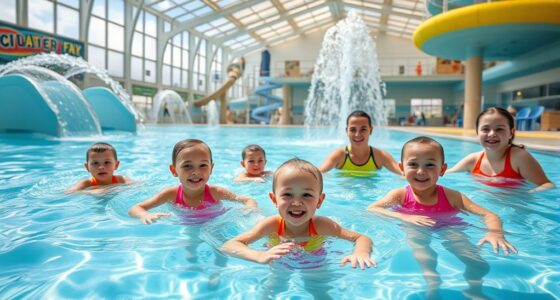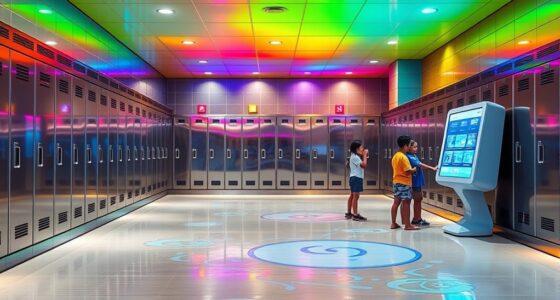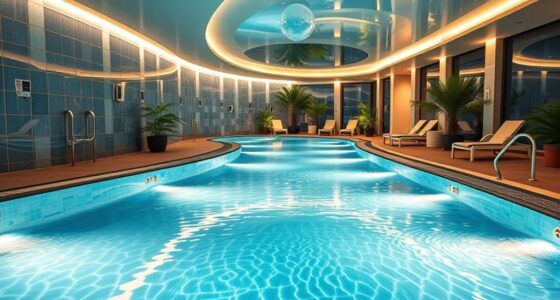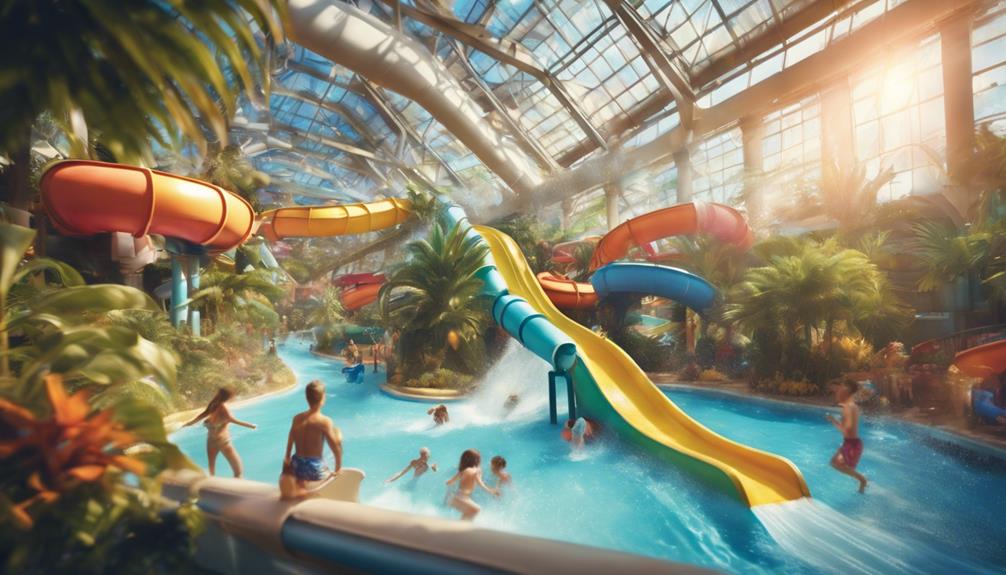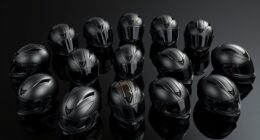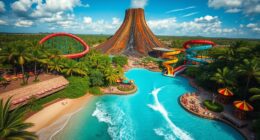For quieter visits, aim for weekdays during the shoulder seasons of spring and fall, avoiding major holidays and school breaks. Off-peak times, like Monday through Thursday in late spring or early fall, usually have fewer crowds and shorter lines. Weather also impacts attendance; rainy or cooler days tend to draw less visitors. If you want tips on how to maximize your indoor water park experience during these quieter periods, keep exploring for more insights.
Key Takeaways
- Off-peak times generally occur during weekdays (Monday-Thursday) in the shoulder seasons of spring and fall, with lower crowds.
- Winter months, excluding holiday peaks, see reduced attendance except during holiday periods and school breaks.
- Summer weekdays tend to have fewer visitors compared to weekends and holiday periods, offering quieter experiences.
- Rainy or stormy days during the off-season increase indoor water park visits, boosting attendance slightly.
- Early mornings and late afternoons during off-peak periods often have shorter wait times and less crowded conditions.
Understanding Seasonal Attendance Variations

Understanding seasonal attendance variations is key to predicting when indoor water parks are most and least crowded. During winter, crowds increase as visitors seek warm indoor environments for recreation. Spring break causes a peak in attendance, with families planning vacations while schools are out. In summer, indoor water parks tend to be less crowded than outdoor parks but still attract visitors craving air conditioning and water fun. Fall sees a slight decline after summer, yet attendance remains steady due to cooler weather and fewer outdoor options. Holiday periods like Christmas and New Year’s also boost attendance, thanks to themed activities and special events. These seasonal shifts are influenced by weather, school schedules, and holiday periods, helping you better plan visits and manage crowd expectations throughout the year. Additionally, understanding seasonal attendance patterns can help you make the most of less crowded times and enjoy a more relaxed experience.
Weekday vs. Weekend Crowd Dynamics in Off-Seasons

Weekday and weekend crowds in indoor water parks during off-seasons vary markedly, shaping your experience and operational planning. On weekdays, you’ll find considerably fewer visitors, especially Monday through Thursday, meaning shorter wait times and a more relaxed environment. Weekend, however, often reach near 100% occupancy, driven by local visitors and weekend travelers seeking family fun. Admission prices are higher on weekends, reflecting increased demand and crowding. While weekday attendance remains enough to sustain revenue, it’s lower than weekends, prompting some parks to limit ride availability or adjust staffing. Hotels with waterparks see increased weekday occupancy thanks to waterpark amenities attracting guests outside peak seasons. Overall, weekday visits offer a quieter, more comfortable experience, while weekends bring vibrant energy and busier conditions. Additionally, crowd patterns can be influenced by specific seasonal factors and local holidays, affecting both attendance and park operations.
Peak Indoor Water Park Seasons and Why They Matter

Peak indoor water park seasons are driven by holiday and school breaks, making these times especially busy. Summer months attract the most visitors due to warm weather and vacations, while winter breaks and spring holidays also see surges. Understanding these peaks helps you plan visits to prevent crowds and ensure a better experience. Visitor patterns demonstrate how these busy periods can impact wait times and overall enjoyment. Additionally, awareness of heat pump performance in extreme weather conditions can help facilities better prepare for seasonal fluctuations and maintain optimal comfort levels for visitors.
Holiday and School Breaks
Indoor water parks experience major attendance spikes during holidays and school breaks because families and groups seek weather-proof entertainment options when outdoor attractions are less appealing. During Thanksgiving, winter (December and January), and spring break, attendance surges as visitors look for indoor fun. Data shows that these periods consistently draw near-capacity crowds, with hotel occupancy filling almost-100% on weekends and breaks. These peaks extend the water parks’ operating season beyond summer, attracting visitors year-round. Families and multi-generational groups tend to visit during these times, often booking special events and group packages. International and domestic travelers also prefer indoor parks during holidays for reliable, weather-dependent experiences. For operators, these periods generate predictable revenue and support ongoing investments, making them essential to the water park’s annual cycle. Seasonal demand is a key factor in maximizing profitability during these peak periods. Additionally, understanding visitor patterns helps optimize staffing and resource allocation during these busy times.
Summer Peak Attendance
Summer is the most dynamic season for indoor water parks, as their highest attendance coincides with warm weather and school vacations. During this time, peaks align with spring and summer breaks, especially in colder regions where families travel despite regional climates. Attendance often exceeds 1.5 million annually, with July reaching the highest occupancy levels. Hot days boost crowd sizes, as visitors seek cooling activities indoors, while cooler or overcast days see declines. Family vacations, weekends, and local festivals drive attendance spikes, amplified by marketing and new ride launches. Economically, summer peaks increase hotel rates and revenue, but also challenge operations with staffing and maintenance needs. To maximize profits, waterparks often schedule expansions outside peak months, capitalizing on the summer surge. Social media sharing and targeted marketing campaigns further amplify attendance during this season, encouraging visitors to share their experiences and bring in more guests.
Midweek Advantage: Best Days to Visit During Off-Peak Periods

Visiting water parks midweek offers a clear advantage for those seeking a more relaxed experience. During these days—Monday through Thursday—you’ll encounter fewer visitors, shorter lines, and more open space. This makes it easier to enjoy rides and attractions without the usual crowds. Social media sharing is also more enjoyable during quieter times, as you can capture and post your favorite moments without the rush. To maximize your visit: 1. Plan your trip on a weekday, especially midweek, for quieter surroundings. 2. Look for special deals or discounts often available during off-peak days. 3. Try to visit during off-peak seasons like spring or fall for even fewer visitors. These strategies help you avoid the weekend rush, enjoy more comfortable surroundings, and get the most out of your waterpark experience. Additionally, visiting during off-peak seasons allows you to experience the park with more staff available for assistance and improved safety. Midweek visits truly offer a more relaxed, enjoyable day at the park.
Impact of School Breaks and Holidays on Indoor Park Crowds

School breaks and holidays cause crowds to surge at indoor water parks, as families plan trips during these peak times. You’ll notice visitor numbers spike markedly during these periods, especially on holiday weekends. Weekday visits tend to be quieter, but weekends and holiday events draw the largest crowds. Seasonal visitor patterns often reflect these school calendars, influencing staffing and operational planning. Additionally, Halloween celebrations can lead to temporary increases in attendance, with themed events attracting more visitors.
Increased Attendance During Breaks
Indoor water parks experience significant surges in attendance during school breaks and holidays, as families take advantage of their time off to visit. During these periods, you’ll notice a sharp increase in visitors, especially in peak months like June, July, and August. This surge is driven by:
- Major holidays such as Christmas and New Year’s, which bring families together.
- Spring and winter breaks, when schools close in various regions.
- Extended weekends and school holiday periods, which maximize family availability.
- Regional school calendars and weather conditions further influence crowd levels, adding variability to attendance patterns.
These times lead to higher ticket sales, longer stays, and more group bookings. Parks often respond by adding special events, extending hours, and implementing dynamic pricing. Expect crowded pools, lively atmospheres, and busy amenities during these peak times.
Holiday Event Crowds Rise
During major holiday periods like Christmas, New Year’s, Thanksgiving, and Spring Break, indoor water parks see a significant increase in visitors. You’ll notice crowds surge as families with children flock indoors for entertainment while schools are out. Attendance peaks in late February, mid-March to mid-April, and around November and December holidays, aligning with school breaks in many regions. Holiday weekends, in particular, bring higher demand, often resulting in capacity limits, longer wait times, and more bookings for on-site lodging. Parks in colder climates rely heavily on these periods, as outdoor options are limited in winter. Resorts and urban parks benefit from targeted holiday marketing, drawing larger crowds. Expect staffing increases and special programming designed to manage and enhance the holiday experience. Incorporating rustic decor and themed attractions can also elevate the festive atmosphere during these busy times.
Weekday Vs Weekend Peaks
Weekends typically draw the largest crowds to indoor water parks because families have more free time and prefer to visit together when schools are in session. During these days, Saturdays are the busiest, often reaching peak attendance. When school breaks happen, this difference diminishes as crowds surge on weekdays too. To make the most of your visit, consider these strategies:
- Visit mid-week, especially Monday through Thursday, when crowds are lighter.
- Arrive early or late in the day to avoid peak hours.
- Use online crowd trackers to identify less busy times, particularly during school breaks or special events. Crowd patterns can vary significantly depending on seasonal factors and regional holidays.
School breaks and holidays considerably boost attendance, often making weekdays just as crowded as weekends. Planning around these periods helps ensure a more relaxed experience.
How Weather and Climate Influence Indoor Water Park Attendance

Weather and climate play a significant role in shaping attendance patterns at indoor water parks. During extreme summer heat, outdoor parks become less appealing, prompting more visitors to seek refuge indoors. In winter, especially in northern regions, cold weather drives families to indoor water parks for warm, indoor recreation. Spring break sees a surge as moderate weather and school holidays encourage travel. Rainy or stormy days further boost indoor water park attendance, providing a weather-proof escape. Climate change adds to this variability, with more frequent heatwaves and storms making outdoor plans unreliable and increasing indoor park visits. Regional differences also matter: southern states face storm disruptions, while milder winters in Florida keep indoor parks busy year-round. Overall, weather unpredictability pushes visitors toward the comfort and safety of indoor water parks. Weather patterns and climate variability significantly influence when people choose indoor water parks over outdoor alternatives.
Special Events and Promotions That Shift Crowd Patterns

Special events and promotions play a crucial role in shifting crowd patterns at indoor water parks by attracting visitors during specific times. You’ll notice that holidays like Independence Day, Memorial Day, and Labor Day draw larger crowds because of extended weekends and summer activities. Themed events, such as Halloween or Christmas celebrations, lure guests seeking unique experiences. Additionally, discounts and promotions on particular days encourage more visitors looking for value. These marketing strategies are often complemented by targeted advertising campaigns that further increase attendance during off-peak times. For example, special event promotions often lead to significant increases in attendance. 1. During school breaks and summer vacations, attendance spikes as families plan vacations around these times. 2. Concerts and live shows hosted inside the park also draw in additional crowds seeking entertainment. 3. Special promotions, like group discounts or social media campaigns, effectively shift attendance by enticing visitors to come during less busy periods.
Tips for Visiting Indoor Water Parks During Quieter Seasons

Visiting indoor water parks during quieter seasons can greatly enhance your experience by allowing you to enjoy attractions without the crowds. To maximize this, plan your visit on weekdays during school months or arrive early in the morning or late in the afternoon. Avoid major holidays and special events, which attract more visitors. Use online crowd trackers to monitor busy times and select quieter days. Consider mid-season discounts, as many parks offer lower prices during off-peak periods. This way, you’ll encounter shorter lines, more space, and a relaxed atmosphere. Flexibility is key, so check park calendars and stay alert for local events that might impact attendance. Booking in advance guarantees better deals, making your quieter-season visit both enjoyable and affordable. Being aware of peak vs. off-peak seasons can help you plan the ideal time for your visit.
Leveraging Data to Optimize Your Water Park Experience

Utilizing data analytics transforms how you can plan your water park visits for a more enjoyable experience. By analyzing attendance patterns, you can identify *ideal* times to visit and avoid crowds. Here’s how to leverage this data:
- Track real-time visitor flow and wait times using mobile apps to find midday lulls or midweek dips.
- Use dashboards that combine weather, bookings, and attendance data to forecast less crowded days.
- Implement targeted promotions during off-peak periods, encouraging visits when crowds are lower.
- Be aware of privacy policy implications when sharing personal data to access real-time visitor information, ensuring your privacy preferences are respected.
Regional and seasonal data reveal that weekdays, shoulder seasons, and certain hours tend to be quieter. By understanding these trends, you can maximize fun, minimize wait times, and make the most of your water park adventure.
Frequently Asked Questions
How Do Indoor Water Parks Maintain Attendance During Off-Peak Seasons?
You keep attendance steady during off-peak seasons by offering discounts and special deals that attract visitors. Implement loyalty programs to encourage repeat visits and host themed weekends or events to generate excitement. Promote these offers through social media, email marketing, and influencer partnerships to reach a broader audience. Additionally, hosting private events and providing local resident discounts help maintain a steady flow of guests, ensuring your water park stays lively year-round.
Are There Specific Indoor Water Park Days With the Lowest Crowd Levels?
You’ll find the lowest crowd levels on weekdays, especially Monday through Thursday, outside of holiday periods. Arriving early in the morning or visiting late in the afternoon can also give you a more relaxed experience with fewer people. Avoid weekends and school holidays, when families tend to visit more. If you’re flexible, go during non-holiday weekdays to enjoy the water park with minimal crowds and shorter lines.
How Do Indoor Water Parks Manage Capacity During Busy Holiday Periods?
During busy holidays, indoor water parks control capacity by implementing advanced reservation systems. For instance, a park might require you to book your entry time online, preventing overcrowding. They also set strict capacity limits, with staff stopping entry once reached. By staggering arrival times and communicating updates via apps and social media, you can enjoy your day without feeling overwhelmed. These strategies guarantee safety and fun during peak times.
What Amenities Are Less Crowded During Off-Peak Times?
During off-peak times, you’ll find fewer crowds at food courts, making it easier to enjoy meals without long lines. Lazy rivers, wave pools, and leisure pools are also less busy midweek, so you can relax more comfortably. Children’s play areas and party rooms see lighter attendance, giving you space to enjoy with your family. Visiting early or late can further enhance your experience, offering quieter, more relaxed amenities.
Can Indoor Water Parks Offer Special Deals to Attract Visitors in Slow Seasons?
Yes, indoor water parks can attract visitors during slow seasons by offering special deals. You could provide discounted tickets, package deals with hotels or local attractions, limited-time promotions, or loyalty programs. Partnering with local businesses or community groups can also boost attendance. Use social media campaigns, email marketing, and themed events to spread the word and appeal to budget-conscious families seeking fun experiences during quieter times.
Conclusion
So, next time you’re hoping for a peaceful splash, remember—off-peak isn’t always empty. Ironically, the quietest days often come when everyone’s dreaming of summer or holiday escapes. By understanding the seasonality and timing, you can dodge the crowds and enjoy a serene swim. Who knew that visiting during the “least busy” times might just turn into your most relaxing adventure? Sometimes, the quietest days make the biggest splash.



